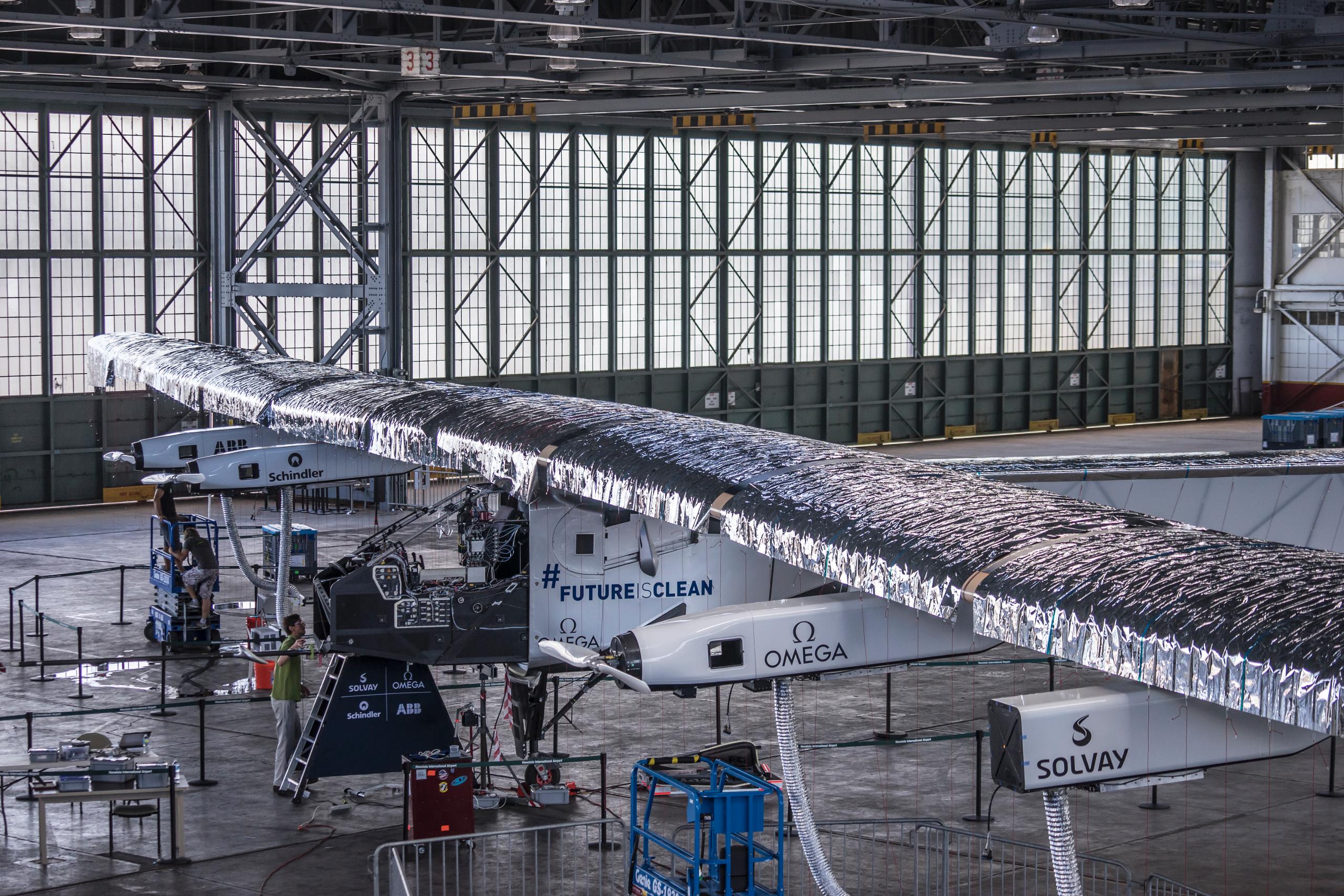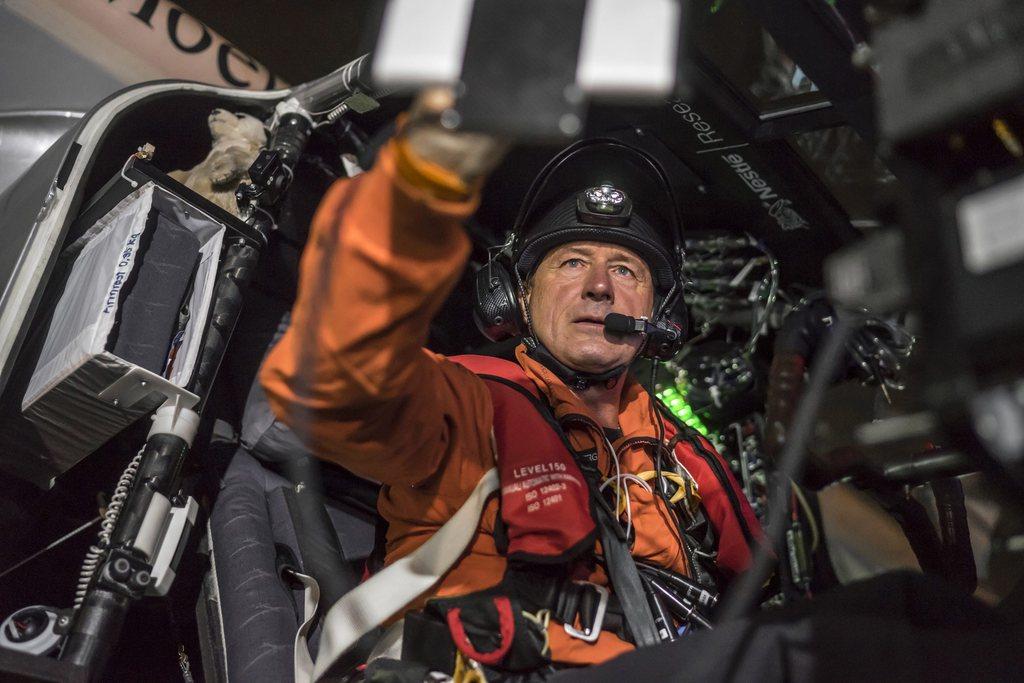What’s next for Solar Impulse 2?

With Solar Impulse’s round-the-world tour grounded until next spring, the team behind the Swiss solar plane must invest a lot more energy and funds into making it airworthy again. But are its big-name sponsors still on board?
“We have roughly 120 people on the payroll, plus the costs of flying next year, so it’s about CHF20 million ($21 million) that we need,” Bertrand Piccard, the project’s initiator, told swissinfo.ch. Many of the employees are on temporary contracts that would have ended by late summer anyway, but as Piccard pointed out, “Some of them need to be secured to be sure to have them next year. So it’s a completely new organisation; it would have been easier to finish this year”.
Piccard noted that he would have to “pound the pavement” to get the money in, but said he was optimistic that they would manage.
“Some of our partners have already said that they are very interested in continuing to support us because for them it has been a huge success. For them, [the delay] is even better because it gives them visibility for a longer time. The adventure has captured so much imagination worldwide, that when we start again next year it will be tremendous,” Piccard said, putting a positive spin on the project’s temporary grounding.
Initially, the overall budget was CHF150 million. One partner is the Swiss government, whose total contribution has amounted to about CHF6 million – including the use of airbases in Dübendorf and Payerne.
Starting in Abu Dhabi last March, the original plan was to finish the round-the-world trip by August, making several stops along the way. Hawaii, where Solar Impulse (Si2) landed on July 3, is roughly the half-way point. On its record-breaking, five-day ocean crossing to the island, the batteries overheated and the plane sustained serious damage.

More
‘It was the most difficult decision I ever made’
‘Fully committed’
“Solar Impulse is and remains one of today’s most exciting clean technology projects. Our partnership will last until the end of the round-the-world flight,” Schindler spokesman Florian Meier told swissinfo.ch.
Though unable to give any specific budget-boosting figures, he said that the Swiss elevator maker, one of the four main Solar Impulse partners, would “work closely with Solar Impulse and all the other partners to find a good solution”.
The feeling is similar at chemical group Solvay, another main partner of the project.
“When we signed 12 years ago to be the first partner of Solar Impulse, it was just an idea, there wasn’t even a feasibility study. We have been living through all the development phases and milestones together with SI since 2004 … we have integrated and accepted the risks of such a project,” Lamia Narcisse, spokeswoman for Solvay, said.
Solvay makes various lubricants and light-weight materials that are a part of Si2.
“We are in close discussions with the Solar Impulse teams every day regarding the next steps and we will try to find the best possible scenario,” Narcisse added.
Another of the key backers, Swiss-based electrical engineering firm ABB, confirmed that its partnership would run through 2016, but declined to disclose the financial details of the deal.
“Solar Impulse 2 is a pioneering mission that is stretching the boundaries of technology and human endurance. The fact that Solar Impulse is now facing this delay demonstrates just how difficult it is. At the same time, the fact that the plane has come so far – and set several world records in the process – shows that the mission was entirely worthwhile and we are proud to have been part of it. Taking calculated risks without unnecessarily jeopardising human life is the very cornerstone of innovation. We are confident that it will be completed next year,” said ABB in a statement.
The fourth main partner, Swiss watchmaker OMEGA, also remains committed to Solar Impulse.
“Although the Solar Impulse project has been grounded until 2016, OMEGA remains proudly dedicated to the mission, with no change in the technical support or enthusiasm we have always contributed,” said OMEGA in a statement, adding, “We know that a project on this scale will always face challenges. Therefore, we stand by this decision and look forward to the flight taking off once more”.
New power
In theory, Si2 could have continued flying as is, but the risk of battery failure was too high. Now the task is to improve the battery system – in particular the insulation and ventilation of the four batteries – so that nothing gets overheated.
“We over-insulated the batteries and made a first climb that was too steep at the start of the [Japan-Hawaii] mission. The batteries started to overheat, and we could never bring the temperature down because of the over-insulation. Now we’re going to correct that mistake,” Piccard said, explaining that overly robust insulation had kept the batteries too warm in the tropical climate over the Pacific.
The new batteries should be ready by September or October, but by then the days will be too short for Si2 to continue the round-the-world journey. For this reason, the mission has been postponed until next spring.
(With input from Anand Chandrasekhar)

In compliance with the JTI standards
More: SWI swissinfo.ch certified by the Journalism Trust Initiative












You can find an overview of ongoing debates with our journalists here . Please join us!
If you want to start a conversation about a topic raised in this article or want to report factual errors, email us at english@swissinfo.ch.